| - 2 - |
 Sofia Potocki
Sofia Potocki |
There are two versions of Sofia's descent. According to the first one (Boscamp-Liasopolski 1789), she was born in 1760 (sometimes 1761 or 1762 are mentioned) on the 1st of January in Turkish town Bursa, 100 km from Istanbul, in the province Bitinia, in the family of an impoverished Greek merchant Kostiantyn. In 1770, Sofia's family moved to Istanbul. Her father died in 1775 (not an exact date), her mother got married to an Armenian, who died soon after that. In addition, their house burnt during a great fire in Istanbul. Maria, having followed her younger sister's example, became a courtesan and earned money in Pera district, where foreign embassies were situated.
On the 10th or 11th of May, 1777, the circumstances forced Maria to take her daughter Dudu (this name was used by family members) to Polish ambassador in Turkey, Karol Boscamp-Liasopolski by name. Sofia's outstanding beauty astounded him, so that he asked her to stay in the palace and hired a French teacher for her.
In a Polish mission Sofia was a great success. Boscamp took her to semi-official receptions; he showed up with Sofia among diplomats, they went for countryside walks together in the outskirts of Istanbul. On the 27th of May 1778 Boscamp went to Warsaw. Before his departure, Boscamp rented a flat for her and opened an account of 1500 piasters as a dowry in case of their marriage. Being very grateful, Sofia wrote romantic letters to him, and in 1778 she received an invitation to come to play a previous role and a promise that she would become a wife of a rich merchant. In January 1779 Sofia headed for Poland through Bulgaria, but she failed to get to Warsaw.
|
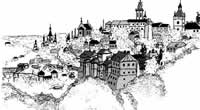 Kamenets
Kamenets |
On the 3rd of April Sofia arrived in Kamenets, there she got acquainted with a commandant of Kamenets fortress, a 39-year-old major Josef Witt. She made him believe (another version of Sofia's descent), that she came from a famous family of Pantalis Mavrokordato (who belonged to a royal family), connected with the owners of Byzantium, that she was a daughter of Pantalis' and Greek magnate's granddaughter, that she was Boscamp's fiancŭe traveling to Warsaw. The ardent major fell deeply in love with Sofia, so on the 14th of June Sofia and Josef got married secretly in the village of Zelenivka, not far from Kamenets. Old Witt got angry with his son's behavior, but Sofia's charm made him agree to accept it as a fact. The general's family was interested in spreading the version about Sofia's aristocratic descent. Merchant Glavani (he was a husband of Sofia's aunt from Istanbul), who arrived in Kamenets to use Sofia's success, helped a lot. Later, Sofia sent him to Warsaw, Boscamp helped him to become a translator of oriental languages there.
In 1781 a newly married couple went to travel all across Europe.
|
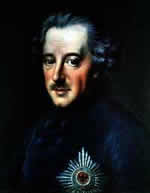 King of Prussia Fredrik II
King of Prussia Fredrik II |
First, they visited Warsaw, where Sofia was the king's guest. At the beginning of March she was introduced to Stanislaw August. This visit opened the way to top social hierarchy for her, and since that time major Josef Witt had become just an ordinary husband of famous Sofia. Sofia spent wonderful two months in Warsaw. Wherever she showed up, her beauty impressed everybody very much. Then Sofia and Josef traveled through Berlin, Sofia got acquainted with the King of Prussia Fredrik II there; she spent some time with Austrian King Josef II in a resort town Spa, she fascinated him and in one of the letters to his sister Maria Antoinette, French queen, he recommended to welcome Sofia. |
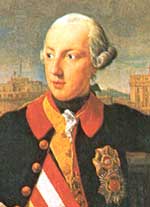 Austrian King Josef II
Austrian King Josef II |
She was really accepted by the queen of France in her rural residence Small Trianon, which was being rebuilt as a landscape park at that very time. It could be that just there Sofia got the idea to create a similar park on her estates in Ukraine. In Paris count Provanski noticed Sofia, later the king Ludovik XVIII and young count d'Artua, future king Karl X. The major, being unhappy, was astonished by fame and glory of his wife. |
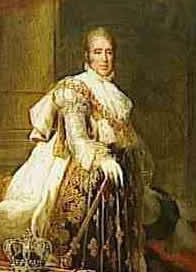 Count d'Artua,
Count d'Artua,
future king Karl X |
On the 17th of November Sofia gave birth to their son and the news spread to Polish king. He visited Kamenets, greeted and congratulated old Witt with his grandson's birth, presented him with the title Lieutenant-General (Witt was Major-General). In 1782 a young couple came back through Vienna, Moravia, Slovakia and Galicia to Kamenets with triumph. In 1785, after old Witt's death, Josef Witt was appointed a new commandant of Kamenets.
|
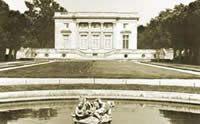 Small Trianon, France
Small Trianon, France |
In 1787 Sofia and a group of Polish magnates visited Istanbul. The king's daughter, corona marshal's wife, Ursula Mnishek, was among tourists. In Constantinople Sofia was given a great reception, she was a great success, the most famous aristocrats tried to meet their countrywoman. Every day of Sofia's stay in Istanbul was a new and fancy holiday, but the rest of the group did not receive so much attention. It had a certain influence on Ursula Mnishek, as a result, the group of magnates traveled without Sofia; probably in Istanbul they came to know something about her past. Anyway, the same year in Warsaw Sofia was given a cold reception. Where Sofia was in winter of 1787-1788 is still a question. Some rumors spread about her being in Petersburg to report to tsarina for the task done. In May 1788 together with duke Sharle-Josef de Linn, who was in military service in Russia, she went to Hotyn, which was surrounded by Russian troops; Sofia often spent time in Russian camp among militants. The Poles were not happy with Kamenets' commandant, and it was due Sofia's contacts with Russians. In 1789 Josef and Sofia arrived in Warsaw, he wanted to get the permission to sell the position of a commandant but he was refused. It resulted in his breaking the relations with Poland.
|
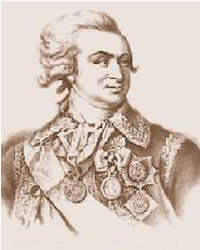 G.Potiomkin
G.Potiomkin |
There is no exact information as to the fact when Sofia got acquainted with the commander-in-chief of Russian army in Russia-Turkey war (1787-1791) general-field marshal G.Potiomkin, but soon she was near Yassy, and her husband was appointed the commandant of Kherson and given the rank of the general of Russian army. When Russian troops seized an invincible fortress of Izmail, Potiomkin went to Petersburg and invited the Witts there. On the 18th of March 1791 Sofia met with Katharine II. |
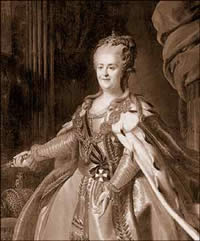 Katharine II
Katharine II |
Following Potiomkin's example, the tsarina gave her a gracious reception and presented her with diamond earrings and an estate in Byelorussia. On his way back, in Ukraine, Potiomkin met commander of Polish army Josef Poniatovski, Sofia asked him to convey her regards to the king. In his reply to his nephew the king wrote: "When you have the chance, tell Sofia that I appreciate everything she has told you about me and I always hope to cherish her good attitude to me" (Letter of August 28, 1791). On the way to Yassy Potiomkin got sick and died on the 5th (16) of October. Thus, Sofia lost her powerful patron.
When Sofia came back to Yassy, she noticed S.Potocki. F.I.Rolle (Rolle, 1966) affirmed that Sofia was G.Potiomkin's agent; she inclined Potocki to fight against a new Polish Constitution. There is no proof of it, and the facts say the opposite. A soon the king understood that S.Potocki, S.Rzhevutski and K.Branytski decided not to obey the new constitution, Stanislaw Kostka Potocki was sent to Yassy to persuade the magnates to come to Warsaw and to recognize the constitution. S.K.Potocki wrote to the king: "I am sure that without this mischievous man (Rzhevutski), Sofia Witt and I would make the general listen to his common sense, besides, she helped me a lot and caused some problems for Rzhevutski." On the 27th of January 1792 Polish Seim made a decision to deprive S.Potocki and S.Rzhevutski all their state positions.
| |
 |
 | In the history of foundation, construction and development of "Sofiyivka" we distinguish six different periods throughout the years.
- 1796-1831. The Foundation.
- 1831-1859. The Tsarina's garden.
- 1859-1929. The School of Horticulture.
- 1929-1955. The State Reserve.
- 1955-1980. The Academy of Science.
- 1980 till present.
|
|
 |
| The park, as a scientific institution of the National Academy of Science of Ukraine, is engaged in researches of connatural and cultural flora of austral Forest-steppe of Ukraine, introduction and acclimatation of plants in the region. The article of the director of the famous park I. Kosenko summarizes this work: |
| 50 years anniversary of the Sofiyivka park as a scientific institute of the Ukraine's NAS |
|
| In the final article of I. Kosenko the review of the park's whole history from the moment of the foundation till todays is made: |
| 205 years since the foundation of Sofiyivka |
|
| The team of scientists of the park issued the catalogue of plants with the total amount 1994 taxons, in which 25 taxons of hazels, 24 beeches, 41 fir-trees, 44 junipers, 100 lianas, 320 roses, 57 rhododendrons and 98 flower plants - totally 1220 trees and bushes and 774 herbaceous plants.
|
| Catalogue (zip 380 КB) |
|
| The hothouse of the park is the unique center of cultivation of conifers and deciduous trees, bushes, roses seedlings - total more than 200 items. | Price-list
Open|Download (22 КB) |
|
| The beauty of the park was sung by a lot of poets, but the poem of the Polish poet S. Trembecki occupies an especial place. Written in 1811, it is the park guide book in verses.
"Sofiowka" and comments of Adam Mickiewicz (polish) |
| | Park as the tourist center offers the visitors a complex of services - excursion support in six languages, hotel, restaurant, conference hall etc. | | List of services |
|
|